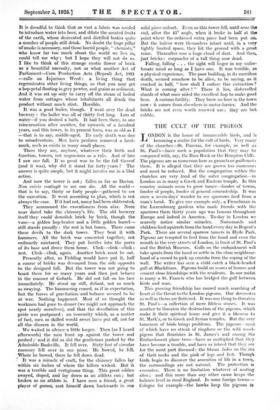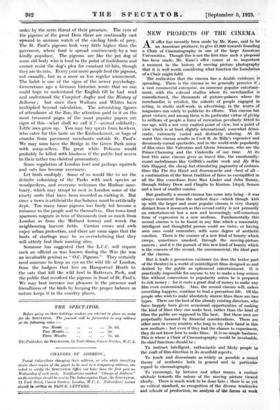THE CULT. OF THE PIGEON
LONDON is the home of innumerable birds, and is becoming a centre for the cult of birds. Very many of the churches—St. Pancras, for example, as well as St. Paul's—have such a population that they may be compared with, say, the Bass Rock or the Bempton Cliffs. The pigeons are as numerous here as gannets or guillemots there. It is alleged that they are grown too numerous and must be reduced. But the congregation within the churches are very fond of the outer congregation—in London as in many a Greek and Eastern temple. In this country animals seem to grow tamer—fonder of towns, fonder of people, fonder of general comradeship. It was once a seven-days' wonder to see sparrows feed from a man's hand. To give one example only, a Frenchman in the Luxembourg gardens who made friends with the sparrows there thirty years ago was famous throughout Europe and indeed in America. To-day in London we scarcely notice similar miracles. .Nursemaids and children feed squirrels from the hand every day in Regent's Park. There are several sparrow tamers in Hyde Park. Pigeons are tempted to feed from the hand and even the mouth in the very streets of London, in front of St. Paul's and the British Museum. Gulls on the embankment will take sprats from the hand or settle in the close neighbour- hood of a crowd to pick up crumbs from the coping of the wall. The writer has seen a child catch a black-headed gull at Blackfriars. Pigeons build on scores of houses and cement close friendships with the residents. In our midst is many a St. Francis who has bridged the gulf between birds and man.
This growing friendship has caused much searching of heart at the threat to the London pigeons. Our dovecotes as well as theirs are fluttered. It was one thing to threaten St. Paul's—a collection of mere lifeless stones. It was another to threaten the destruction of the pigeons, which make it their spiritual home and give it a likeness to St. Mark's, or to Greek and Syrian temples. But the very tameness of birds brings problems. The pigeons—most of which have no streak of ringdove or the wild wood- pigeon that flOitrishes. in 'St. James's and among the Embankment plane trees—have so multiplied that they have become a trouble, and have so inbred that they are for the most part diseased : the bloom fades on the iris of their necks and the pink of legs and feet. Though birds begin to discover the amenities of life in a town, the surroundings are not natural. The protection is excessive. There is no limitation whatever of nesting sites ; and this more than any other cause keeps the balance level in rural England. In some foreign towns— Cologne for example—the hawks keep the pigeons in order by the mere threat of their presence. The eyes of the pigeons of the great DoM there are continually cast upward in anxious watch of the circling birds of-prey. The St. Paul's pigeons look very little higher than the pavement, where food is spread continuously by, a too kindly populace. The pigeons are like the pet dog of some old body who is fond to the point of foolishness and cannot resist the dog's plea for Constant tit-bits, though more they are its ruin. Every year more people feed the pigeons, not casually, but as a more or less regular amusement. The habit is one of the Signs of the newer psychology. Generations ago a German historian 'wrote that- no one could hope to understand the English till he had read and underitood the Conipleat Angler and the History of Selborne; but since then Waltons and Whites have multiplied beyond calculation. The astonishing figures of attendance at the Zoo, the attention paid to it on the most treasured pages of the most popular papers are signs of this—what shall we call it ?—animal solidarity. Little zoos grow up. You may buy sprats from hawkers, who cater for this taste on the Embankment, or bags of crumbs- from pavement merchants outside St. Paul's. We may soon have the Bridge in the Green Park noisy with scrap-sellers. The great white Pelicans would probably be killed with kindness if the public had access to their rather too cloistral promontory.
Some regulation of London fowl and perhaps squirrels and cats has become necessary. • - - Let birds multiply. Some of us would like to see the definite colonizing of the Parks with such species as woodpeckers, and everyone welcomes the Hudson Sanc- tuary, which may tempt to nest in London some of the ninety sorts that have been recorded as visiting it. But since a town is artificial the due balance must be artificially kept. Too many tame pigeons too freely fed become a nuisance to the people and to themselves. Our town-bred sparrows migrate in tens of thousands (not so much from London as from the Midland towns) and wreck the neighbouring harvest fields. Carrion crows and owls enjoy urban protection, and there are some signs that the hosts of starlings may be so overwhelming that they will utterly foul their roosting sites.
Someone has suggested that the L.C.C. will require such an official as was known during the War (he was an invaluable genius) as " O.C. Pigeons." They certainly need someone to keep an eye on the wild life of London, from the badgers that live on Hampstead Heath to the cats that kill the wild fowl in Battersea Park, and the public that overfeed the pigeons in front of St. Paul's. We may best increase our pleasure in the presence and friendliness of the birds by keeping the proper balance as nature keeps it in the country places. •











































 Previous page
Previous page